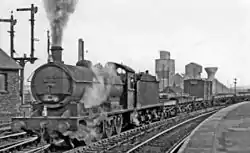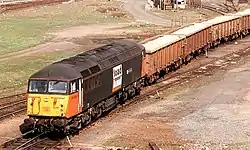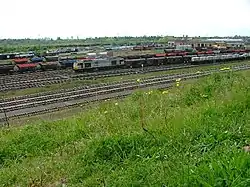Tees Marshalling Yard
Tees Marshalling Yard is a railway marshalling yard, used to separate railway wagons, located near Middlesbrough in North Yorkshire, Northern England.



Background
The yard lay on the original Stockton and Darlington Railway (S&DR) extension to Port Darlington, developed from 1828 under the instructions of influential Quaker banker, coal mine owner and S&DR shareholder Joseph Pease, who had sailed up the River Tees to find a suitable new site down river of Stockton on which to place new coal staithes. As a result, in 1829 he and a group of Quaker businessmen bought 527 acres (213 ha) of land described as "a dismal swamp",[1] and established the Middlesbrough Estate Company. Through the company, the investors intended to develop both a new port, and a suitable town to supply its labour.[1] On 27 December 1830, the S&DR opened an extension across the river to a station at Newport, almost directly north of the current Middlesbrough railway station.[1] The S&DR quickly later renamed this new station and associated six-coal staithe dock facility as Port Darlington,[2] hoping to market the facility further. So successful was the port, a year after opening the population of Port Darlington had reached 2,350.[2]
However, with Port Darlington overwhelmed by the volume of imports and exports, in 1839 work started on Middlesbrough Dock. Laid out by Sir William Cubitt, the whole infrastructure was built by resident civil engineer George Turnbull.[2] After three years and an expenditure of £122,000 (equivalent to £9.65m at 2011 prices),[2] the formal opening occurred on 12 May 1842. On completion, the docks were bought by the S&DR.
Erimus Marshalling Yard
As Middlesbrough developed, additional railway facilities were required to marshall goods wagons, and allow workers to access the docks and associated industries. So in 1882 South Stockton railway station was built by the North Eastern Railway, opened on 1 October. In 1892 Parliament granted a charter that created the Borough of Thornaby-on-Tees, which incorporated the village of Thornaby and South Stockton, and so on 1 November 1892 the name of the station was also changed.[3]
Thornaby was located on a busy and hence important section of the line for the NER, between Newport and Middlesbrough Dock to the east, and Bowesfield Junction to the west, which had the busiest signal box on the NER system.[3] In 1910, the NER hence built the new Erimus Marshalling Yard, named after the motto of Middlesbrough.[4]
In 1914, as an early adopter of overhead line railway electrification, the NER built the Electric Freight 1 locomotives to haul coal from the Witton Park Colliery at Shildon, along the former Clarence Railway to Redmarshall and then down the Castle Eden Railway to Erimus, for export from Middlesbrough Dock. During the 1920s the coal traffic declined and some of the locomotives became surplus to requirements. The NER was grouped in 1923 as part of the London and North Eastern Railway, and by the 1935 the LNER had replaced the electric locomotives with steam.[5]
Although bombed by the Nazi Luftwaffe during World War II, the yard survived and thrived.
Tees Marshalling Yard
In the mid 1950s as part of British Railways modernisation plan, projects were developed to centralise the marshalling of goods wagons and the associated servicing of steam locomotives at the UK's largest freight hubs.[5]

Teesside had a number of marshalling yards servicing the coal mines and steel mills of Consett, West County Durham and North Yorkshire, as well as those for Middlesbrough Dock. The decision was hence taken to rationalise these to one yard, and in 1957 to the immediate west of Erimus, BR developed the new Tees Marshalling Yard and associated Thornaby TMD.[6] Initially developed as a hump shunting facility, by the time construction was completed in 1963 wagon-shunting had been replaced by Containerisation and Merry-go-round trains, and hence hump shunting ceased.[7]
.jpg.webp)
However, with rationalisation in the local coal mining and steel making industry – particularly the closure of Consett Steel Works in 1980 – it closed in stages from 1985 with the run-down of rail freight in the area and Great Britain in general. Taken over by EWS (English, Welsh & Scottish railways) upon the privatisation of British Rail (which then became DB Schenker Rail (UK)), with the closure of Middlesbrough Dock in 1980 and the development of Teesport further down stream, Thornaby became isolated from its main source of traffic.
The Down Yard is completely closed apart from the Down Staging sidings which remain open to all freight operators. The Up yard remains busy to this day shunting traffic for the nearby steel works and as an intermediary point for long distance flows. The Yard consists of Arrivals and Departures at the Thornaby end, numbered 1 to 5 for the Departures and 6 to 12 for the arrivals. There is then a shunt neck leading to 42 Primary sorting sidings. There is a small group of sidings called the Sectional Sidings which are used for wagon Maintenance and Locomotive Servicing. Thornaby Depot closed in 2008 and was demolished in 2011. Most of the track has been lifted, however the old Ash pits are used for wagon storage and there are some sidings to the south called the New Sidings which are used for the storage and maintenance of Tamping machines.
Present
Part of the site has been redeveloped as the 42-acre (17 ha) Maze Park Nature Reserve.[8] Created by the Teesside Development Corporation,[9] the reserve is a narrow triangle of land bounded by the River Tees, the old river Tees, and the former rail marshalling yard,[10][11][12] owned and run by the Tees Valley Wildlife Trust.[10][13]
Middlesbrough Council have the rest of the site marked for long term redevelopment, subject to the mainline railways being moved west on the site, and accepting the fact that the site is within a zone 2 flood risk area.
References
- British Rail Locoshed Directory. Shepperton: Ian Allan Ltd. 1981. ISBN 0-7110-1143-5.
- Baker, S.K. (2001). Rail Atlas Great Britain & Ireland. ISBN 0-86093-553-1.
- "Cargo Fleet". Dusused Stations. Retrieved 24 March 2013.
- Paul Delplanque (17 November 2011). "Middlesbrough Dock 1839–1980". Middlesbrough Gazette. Retrieved 24 March 2013.
- Paul Delplanque (26 June 2009). "The jewel on the line". Middlesbrough Gazette. Retrieved 24 March 2013.
- Appleby, K.C. (1990). Shildon-Newport in Retrospect: the Fore-runner of Main Line Electrification. Lincoln: RCTS. p. 11. ISBN 0-901115-67-3.
- "Thornaby TMD". 10 June 2010. Archived from the original on 20 April 2013. Retrieved 26 March 2013.
- Bulger, Paul (1984). BR Steam Motive Power Depots NER. Shepperton: Ian Allan Ltd. ISBN 0-7110-1362-4.
- "Tees Marshalling Yard". Rail Brit. Retrieved 25 March 2013.
- "Maze Park Nature Reserve". teeswildlife.org. The Wildlife Trust – Tees Valley. Archived from the original on 19 July 2011. Retrieved 4 October 2011.
- "Maze Park". Gazette Live. Teesside: Evening Gazette. 23 May 2007. Retrieved 12 June 2009.
- "Development Strategy – Green Blue Heart". smi-teesvalley.co.uk. Stockton-Middlesbrough Initiative. Archived from the original on 4 October 2011. Retrieved 12 June 2009.
- "Take a trip to Barrage". ICTeesside. Teesside: Evening Gazette. 8 September 2005. Retrieved 12 June 2009.
- "The Green Blue Heart" (PDF). smi-teesvalley.co.uk. Stockton-Middlesbrough Initiative. Archived from the original (PDF) on 4 October 2011. Retrieved 12 June 2009.
- "Brownfields – Habitat Action Plan" (PDF). teesvalleybiodiversity.org.uk. Tees Valley Biodiversity Partnership. Archived from the original (PDF) on 30 August 2011. Retrieved 12 June 2009.